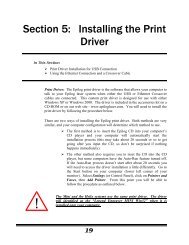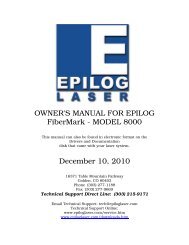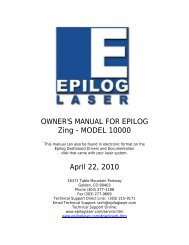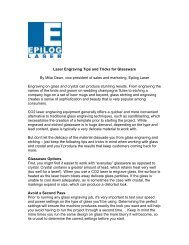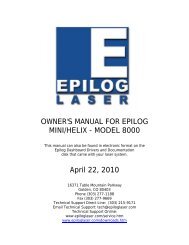Laser Engraving Equipment Exhaust - Epilog Laser
Laser Engraving Equipment Exhaust - Epilog Laser
Laser Engraving Equipment Exhaust - Epilog Laser
You also want an ePaper? Increase the reach of your titles
YUMPU automatically turns print PDFs into web optimized ePapers that Google loves.
<strong>Laser</strong> <strong>Engraving</strong> <strong>Equipment</strong> <strong>Exhaust</strong><br />
By Mike Dean, vice-president of sales and marketing, <strong>Epilog</strong> <strong>Laser</strong><br />
So you’ve decided to invest in laser engraving equipment. Great! But one of the most important<br />
(and often overlooked) aspects of using this type of equipment is properly exhausting your<br />
system.<br />
Proper exhaustion of your laser engraving equipment is paramount in running a safe work area.<br />
It’s not only beneficial to your work environment, but proper exhaustion will also add to the life<br />
of your laser engraving system. While exhaust situations vary depending upon the manufacturer<br />
and size of your equipment, this article discusses the importance of proper exhaustion of your<br />
laser engraving equipment as well as cleaning your exhaust system.<br />
Most business owners utilize a contractor to install their exhaust systems; however, the<br />
information to follow will prove to be helpful as you determine the exhaust system that best<br />
meets your needs.<br />
We should begin with the exhaust blower as it is one of the most important parts of your exhaust<br />
system.<br />
What is an exhaust blower and why is it so important?<br />
The exhaust blower is really just a simple fan that removes dust, debris and odor from the<br />
engraving cavity and exhausts it to the outside of your building structure. People are always<br />
surprised at the amount of smoke that is created, especially when engraving wood, if they forget<br />
to turn their exhaust fan on! The exhaust blower should be operating whenever you use your<br />
machine.<br />
Where do I place my exhaust blower?<br />
To reduce noise levels, we recommend your exhaust blower be mounted outside your building for<br />
noise considerations. The blower should not be more than twenty feet (six meters) from the<br />
laser. This portion of the installation should be installed and tested before your laser system<br />
arrives. It’s usually easy to do, but because you may need to cut a hole in your facility it can<br />
sometimes be the most time consuming part of installation. Starting on exhaust installation as<br />
soon as you order your laser means you can start working immediately upon delivery of your<br />
laser.<br />
What type of ducting do I use?<br />
You should provide a metal duct (flexible aluminum or galvanized sheet metal) from the blower<br />
to the laser. It’s important that either rigid or flexible metal ducting be used for all connections<br />
leading to and from the laser system and the exhaust fan. Vinyl, plastic, or any type of “soft”<br />
ducting is potentially flammable and should never be used.
<strong>Exhaust</strong> Ports<br />
Your laser system will have an exhaust port that is usually located at the back of the machine.<br />
This port will be connected to the inlet side of your exhaust blower using flexible aluminum or<br />
galvanized sheet metal ducting. Then, connect the exhaust side of the exhaust fan to the metal<br />
duct leading outside.<br />
<strong>Exhaust</strong> port hookup located at the back of the machine.
Example of typical exhaust setup.<br />
How big of an exhaust fan do I need?<br />
<strong>Exhaust</strong> fan size varies and is usually determined by the size of your system cabinet. Small<br />
systems require smaller exhausts than larger systems. Your manufacturer will recommend an<br />
exhaust that is rated by two variables – amount of air to move (CFM) and pressure of air (static<br />
pressure). The laser manufacturer will specify that the necessary exhaust fan needs to be<br />
something like a 400 CFM fan at 6 inches of pressure. This is enough information for any air<br />
handling contractor to install the appropriate exhaust fan. Most manufacturers will provide you<br />
with a specific type of fan or source where you can purchase a fan that is suitable for your<br />
system.<br />
Can I use a self-contained filter in place of an exhaust fan?<br />
Yes. There are a number of manufacturers of self-contained filter systems. These filter units are<br />
portable pieces of equipment that attach directly to the laser. Many users use these when they<br />
take their laser systems on the road, but they can also be used in work environments where a<br />
standard exhaust fan cannot be vented to the outside. The filters are three stage filters that<br />
include a pre-filter, a HEPA filter and a charcoal filter. The filters clean the air of large particles,<br />
small particles and the charcoal filters the smell and then releases the cleaned air back into the<br />
work environment.
Cleaning the <strong>Exhaust</strong><br />
Proper maintenance of your exhaust system is of critical importance. We recommend periodic<br />
cleaning of the exhaust blower and duct system to remove any debris or other material that may<br />
have accumulated.<br />
If you detect odor while engraving, or if the smoke in the cabinet is visible in the area of the lens<br />
carriage, inspect the exhaust system. Be sure to check for loose or broken pipe/hose<br />
connections, or obstructions. You should also occasionally check your exhaust blower and the<br />
duct work that is connected to it.<br />
There are a handful of options when it comes to properly ventilating your workspace when using<br />
laser engraving equipment. The most imperative, for both the health of your work environment<br />
and your laser system, is to have a structurally sound exhaust system.



